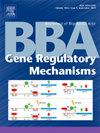Growth rate is related to elongation of RNA polymerase II transcription in Saccharomyces cerevisiae
IF 3.1
3区 生物学
Q3 BIOCHEMISTRY & MOLECULAR BIOLOGY
Biochimica et Biophysica Acta-Gene Regulatory Mechanisms
Pub Date : 2025-06-08
DOI:10.1016/j.bbagrm.2025.195100
引用次数: 0
Abstract
Cells must adapt to changing environmental conditions to maintain their fitness and to compete with other genotypes during the natural selection process. The growth rate (GR) is a determining factor in this competition, and it influences gene expression. Some genes increase mRNA levels, while others decrease with the GR. mRNA levels depend on the dynamic balance between their synthesis by RNA polymerase II and their degradation rates. RNA polymerase I and III are also influenced by the GR because they transcribe protein synthesis machinery required to make proteins that increase cell mass during growth. Although RNA levels have been extensively studied in relation to the GR in many organisms, synthesis and degradation rates have, however, been much less investigated. In a previous work, we found a positive correlation between RNA polymerase (RNA pol) II transcription and mRNA degradation with GRs in yeast in batch cultures. Here we extend our study under constant growth conditions in a chemostat and find that overall chromatin-associated RNA pol II levels increase in parallel with the GR. This increase appears to involve the accumulation of partially dephosphorylated RNA pol II with a greater tendency to backtracking, which suggests that the GR modifies the phosphorylation state of RNA pol II at the elongation level. RNA pol I also increases its association with chromatin with the GR, which confirms the general dependence of at least RNA pol I and II transcription on the GR.
酿酒酵母菌的生长速率与RNA聚合酶II转录的伸长有关。
在自然选择过程中,细胞必须适应不断变化的环境条件,以保持其适应性,并与其他基因型竞争。生长速率(GR)是这种竞争的决定性因素,它影响着基因的表达。一些基因的mRNA水平随着gr的增加而增加,而另一些基因的mRNA水平则随着gr的增加而降低。mRNA水平取决于RNA聚合酶II合成和降解率之间的动态平衡。RNA聚合酶I和RNA聚合酶III也受到GR的影响,因为它们转录蛋白质合成机制,以在生长过程中制造增加细胞质量的蛋白质。尽管在许多生物体中,RNA水平与GR的关系已被广泛研究,但对其合成和降解率的研究却少得多。在之前的工作中,我们发现在批量培养的酵母中,RNA聚合酶(RNA pol) II转录和mRNA降解与GRs呈正相关。在此,我们在趋化器中持续生长的条件下扩展了我们的研究,发现染色质相关的RNA pol II水平与GR平行增加。这种增加似乎涉及部分去磷酸化的RNA pol II的积累,并且更倾向于回溯,这表明GR在延伸水平上改变了RNA pol II的磷酸化状态。RNA pol I也增加了其与GR中染色质的关联,这证实了至少RNA pol I和II的转录对GR的普遍依赖。
本文章由计算机程序翻译,如有差异,请以英文原文为准。
求助全文
约1分钟内获得全文
求助全文
来源期刊
CiteScore
9.20
自引率
2.10%
发文量
63
审稿时长
44 days
期刊介绍:
BBA Gene Regulatory Mechanisms includes reports that describe novel insights into mechanisms of transcriptional, post-transcriptional and translational gene regulation. Special emphasis is placed on papers that identify epigenetic mechanisms of gene regulation, including chromatin, modification, and remodeling. This section also encompasses mechanistic studies of regulatory proteins and protein complexes; regulatory or mechanistic aspects of RNA processing; regulation of expression by small RNAs; genomic analysis of gene expression patterns; and modeling of gene regulatory pathways. Papers describing gene promoters, enhancers, silencers or other regulatory DNA regions must incorporate significant functions studies.

 求助内容:
求助内容: 应助结果提醒方式:
应助结果提醒方式:


